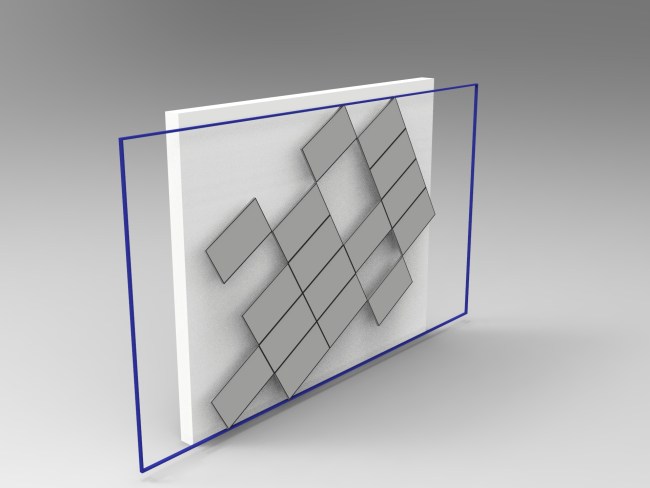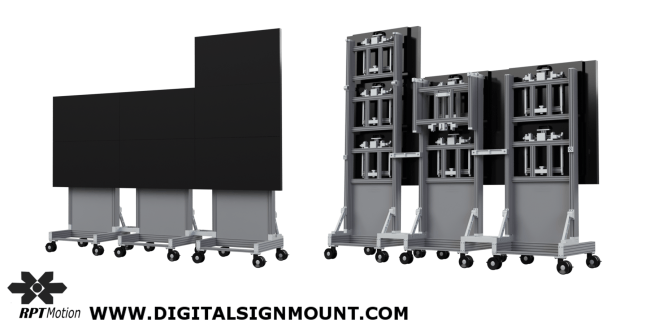Portable Video Walls aren’t well understood. Frankly, people don’t usually move video walls from place to place because they’re expensive complex systems and the available mounting systems aren’t reliable or simple to move. That’s a shame, we have RPT Modular Video Wall customers who deploy large video walls 40+ times in a few months each year at self-managed trade shows and product launches in smaller cities. Our new RPT PopUp System makes it even easier.
Before you consider the RPT PopUp Portable Video Wall System, you should first look at how you will use your portable video wall. The following questions will help you define your needs and narrow down your selection of portable mounting systems.
Basic questions you need to answer:
Have you ever rented a video wall? A 3×3 video wall will typically cost roughly $10K for a three day event, where they are available. Many smaller cities won’t have easy access to rental video walls, and the costs will multiply if transport and set-up costs are added.
How many monitors will your video wall have? What size monitors?
How many times per year will you move your video wall to maximize its impact and ROI?
Will your video wall stay in one room for its lifetime?
Do you need to move your video wall to different rooms or deploy it on different floors of one facility through standard office doors or on passenger elevators?
Is the primary use for your video wall to take to trade shows? If so are these events at large convention centers or self hosted events at hotels in smaller cities or various customer facilities?
Will your video wall be part of a rental program?
Will your video wall always be deployed in one layout (example fixed as 2 Wide x 2 High Landscape Array) or do you want flexibility and future expandability (example the nine monitors in a 3×3 array could be deployed as two 2×2 video walls)?
What type of content will you display on your video wall, what resolution is that content produced in, and what type of video wall controller will you select to place your content on your video wall?
Who will be responsible for the basic integration of the Portable Video Wall mounting, monitors, player, power distribution, cabling and any other required hardware? Where will all that hardware be mounted?
Once you understand the purpose of owning a portable video wall, you can start looking at ways to mount it and more importantly move it.
Option to explore:
The first thing we will do is send you to another top-notch supplier, so that you can educate yourself to some options. At first glance, RPT PopUp Video Walls will seem to be significantly more expensive than this option, so if this works for you you might be able to save money. Often we find potential customers have budgeted for this type of mounting without fully understanding the limitations. Or worse, they own these mounts and moving the video wall is inconvenient so it never moves place to place.
The lowest cost and simplest portable video wall mounting system is a single cart type of mount for a fixed number of monitors. If this type of mount works for you, please understand the limitations and then choose a quality cart of suitable capacity.
Here’s a link to typical fine example of a quality cart type of single layout mount from Milestone (formerly Chief):
See: http://www.chiefmfg.com/Products/LVM2X2U
It handles up to 50” monitors and provides micro adjustments mounts for the monitors. It is assembled on site from a kit of parts (Assembly manual link: http://downloads.chiefmfg.com/MANUALS-I/LVMSeries-I.pdf) and the completed assembly measures 80.5” high x 72.5” wide x 40” deep without monitors.
This type of simple single layout cart is a good choice for a simple low cost self-integrated video wall that won’t ever be moved room to room or facility to facility. Even without monitors these carts won’t fit through standard office doors or onto passenger elevators unless you take the cart apart to move it. There are wiring passages in the frame, but you will need to integrate and enclose your power distribution and any network or video wall controller hardware you require to move with the video wall.
All of these integration issues multiply if you’re deploying larger arrays (example 3×3) and each layout of array requires a specific model of cart, there is no clean upgrade path to larger arrays or deploying a large array as two smaller ones.
If a simple cart type of mount works for you, it may at first glance seem to be lower cost than the RPT PopUp System, but the time, integration quality and total cost may vary widely.
Monitors are the most fragile part, and the most expensive:
We’ve seen a lot of poorly mounted simplistic modular portable video walls at trade shows and other events from smaller manufacturers. These can take a long time to properly align into an attractive and professional looking array, an exercise that repeats every time you move your video wall.
You really need to be 100% confident in the rigidity and accuracy of the mounting system when using Ultra Thin bezel monitors (3.5mm Bezel-Bezel like the 49″ Philips BDL-4988XC is the smallest bezel we recommend for portable video walls).
Ultra thin bezels make for easily broken monitor glass with any impact especially to corners. Quality monitors are the biggest cost in a video wall and are the most likely components to be broken when moving a poorly mounted in a portable video wall.
RPT highly recommends properly designed road cases for the monitors of a portable video wall to protect the monitors during a move. RPT partners with Calzone Cases for dual monitor road cases predesigned for maximum protection of the 49” and 55” monitors we recommend. These cases allow one person to safely move two monitors at a time.
Why RPT PopUp Portable Video Walls?
RPT provides a rugged precision portable video wall mounting system designed for modern Ultra Thin Bezel monitors.
Our RPT PopUp Video Wall deploys quickly, typically a 2 x 2 wall will be content ready in under 30 minutes, often 15 minutes.
Our Monitor stacks include standard front panels and rear cable bins to catch excess cables, this allows simple integration. As well, we build on t-slotted aluminum and that offers an unlimited number of places to secure cables and other hardware.
For more on integrating RPT PopUp Stacks see: http://digitalsignmount.com/2018/02/06/rpt-popup-video-wall-integration/
RPT offers options like rear doors to make your PopUp Video wall look finished from behind if needed:

If you’re using an HDMI over Ethernet Video Wall Controller like Userful or MonitorsAnywhere, RPT offers mounted ThinGlobal MiniPoint DS Power Over Ethernet Zero Clients at each monitor location.
We will integrate our RPT PopUp System to any desired level, from naked non-folding mounts for you to integrate all the way to fully folding and wired plug and play. Because of that experience, we’ve already answered most of the hard integration questions and can quickly deliver what you need: A reliable and safe portable video wall, or components to help you do the integration yourself.
We offer an optional RPT Modular 4U rack mounted to the back of one or more monitor stacks to carry your network, power distribution, Uninterruptible Power Supply and Video Wall Player or Controller hardware securely and neatly.

We always offer expansion and variety of deployment configurations as a retrofit at any time from a basic 2×2 array through 4 high x as many wide as you want, all without losing your initial investment. This can allow multiple smaller video walls or one large one from your pool of monitors. A common example would be one 3×3 trade show Video Wall deployed as two branch office 2 x 2 RPT PopUp Video Walls when not at trade shows.
Or a collection of several branch office RPT PopUp Video Walls merged into a 17 monitor back wall of a 20 foot trade show booth:

Simply put: RPT PopUp Portable Video Walls are a premium option that will make your Portable Video Wall easier to integrate, more flexible, more reliable and easier to deploy more often in more places.
Tell us what you need to do, you’ve answered the questions above, we have the solution.














 RPT
RPT























